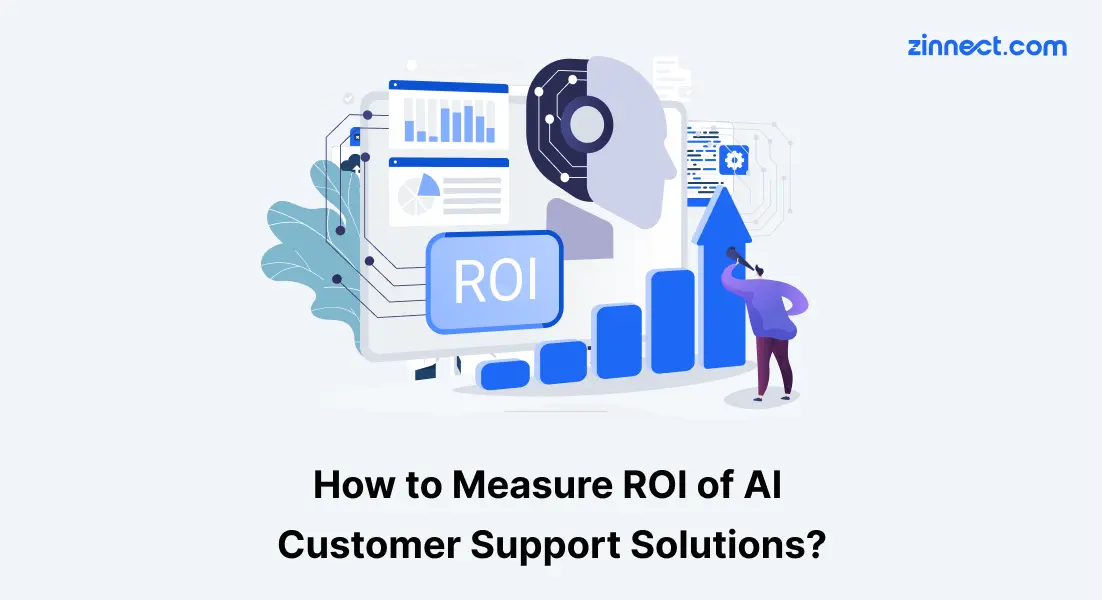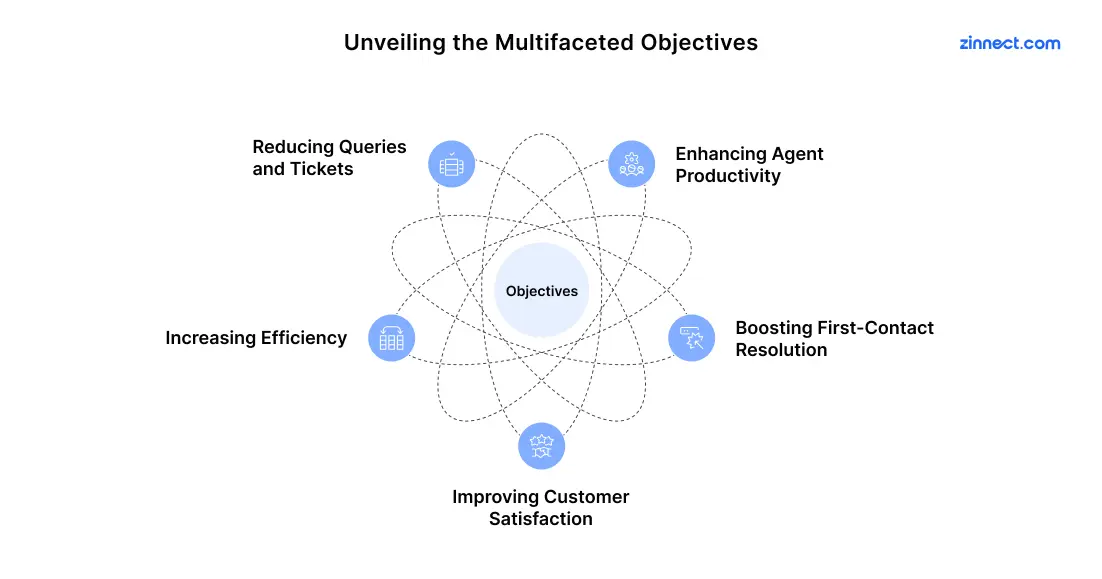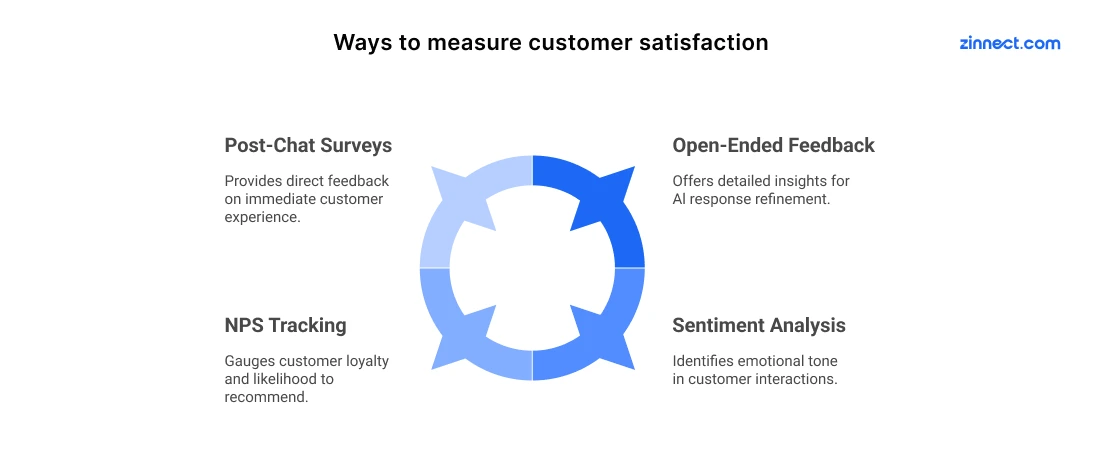How to Measure ROI of AI Customer Support Solutions?

Creating a competitive advantage and sustaining it in a fast-evolving business landscape has become increasingly challenging. Every small improvement, upgrade, and feature that offers convenience to customers contributes to the competitive advantage.
The quality of customer support is among the key factors that impact the customer experience and give businesses a competitive edge. Customers expect seamless, 24/7 customer support, and businesses are under pressure to deliver it while managing rising operational costs and high service expectations.
AI-powered customer support solutions enable businesses to meet their goals, enhance the quality of customer support, and improve the overall customer experience. From chatbots to virtual agents and automated ticket triage, AI is transforming various aspects of the support experience.
However, jumping into the AI bandwagon and investing in the latest and greatest customer support system, encompassing every AI capability, may not necessarily work for everyone. You must understand your needs and choose what works for you, as well as the type of AI customer support solution you should invest in. But how do you measure whether the investment in AI will pay off?
The key lies in understanding and quantifying the Return On Investment (ROI). While AI solutions promise automation, efficiency, and customer delight, stakeholders need concrete AI ROI metrics to justify the spend.
In this article, we explore how businesses can measure the ROI of AI-powered customer support using relevant cost, time, and experience metrics.
7 Steps to Measure ROI of AI Customer Support
Set Clear Goals First
Implementing AI across multiple aspects of customer support can bring significant transformation to your organization. However, it could be completely different and disconnected from your current mode of customer support.
Bringing about such a massive change within an organization introduces significant risks and challenges, including, but not limited to, budget constraints. It takes your focus away and forces you to manage multiple issues at the same time.
So, it is more appropriate to take one step at a time for successful implementation, testing, fine-tuning, and deployment. The primary step in implementing AI in customer support is defining clear business objectives. Your objectives could include:
- Reducing the queries directed to live agents and the number of human-handled tickets
- Increasing efficiency by reducing Average Handling Time (AHT)
- Improving Customer Satisfaction Score (CSAT)
- Increasing first-contact resolution (FCR), thereby reducing the need for follow-up
- Boosting agent productivity and reducing churn

Once you have selected a goal, you can set that as a baseline, focus your AI customer support implementation around it, and provide a framework for measuring success.
Track Cost Savings
Return on investment (ROI) is a calculation of how much you invest in AI customer support in relation to how much value you can get out of it. So, customer support cost reduction is a significant aspect of ROI. You must forecast the cost savings you will achieve by implementing AI customer support.
For instance, AI systems handle common, repetitive queries and basic troubleshooting, reducing the need for large human support teams. They save the costs involved in paying wages for additional human staff who would have handled those queries in the absence of AI customer support. You can estimate these cost savings.
Similarly, you can identify other areas of customer support cost reduction by tracking key metrics, including:
- Cost per ticket before and after AI implementation
- Reduction in hiring, training, and onboarding costs
- Infrastructure savings from cloud-based or scalable AI platforms
For instance, if the cost per ticket handled by a live agent is $10 and AI deflects 8,000 tickets monthly, then this would result in a $80,000 monthly savings.
Measure Time Saved
In addition to the direct cost savings, there are also indirect cost savings – for instance, the time spent addressing one query costs in terms of human labor and other resources in traditional customer support. When you implement AI customer support, you can dramatically reduce the time spent on addressing repetitive queries.
While live agents may spend time pulling up customer details, order information, and previous interactions to provide solutions that involve common tasks, such as order cancellation, AI customer support automates all that, reducing the Average Handling Time (AHT). This metric helps assess time saved per interaction. When you combine AHT with volume handled, you can quantify labor hour reductions.
Time saved = (AHT before AI − AHT after AI) × number of tickets
Suppose the Average Handling Time (AHT) before implementing AI customer support was eight minutes, and after AI, it dropped to three minutes. The total time saved handling 10,000 tickets per month would be:
(8 − 3) × 10,000 = 50,000 minutes per month.
50,000/60 = 833.33 hours saved
By multiplying the time saved by the average hourly agent cost, you can calculate dollar savings.
833.33 × $20 (average hourly agent cost) = $16,666.60 of total monthly savings
Monitor Response & Resolution Times
The monetary benefit of customer experience can be hard to measure. A good customer experience can be a key factor in customer retention and repeat purchases. Good customer experience in support stems from faster response and resolution times. Improved resolution speed correlates with higher Net Promoter Scores (NPS) and CSAT.
AI chatbots with NLP can simulate human-like responses and often resolve simpler queries faster, reducing escalations to human support.
Intelligent ticket routing also reduces waiting times by identifying common queries and routing them to chatbots while sending complex queries to live agents. As a result, regardless of whether a query is directed to a human agent or AI support, First-Contact Resolution (FCR) is achieved, improving speed, efficiency, and customer experience.
A few metrics you can track to measure response and resolution times include:
- Average Response Time (ART)
- First-contact resolution rate
- Escalation rate to human agents
Use CSAT and Feedback
Customer satisfaction is another factor to consider while projecting the monetary value of customer support. Customer satisfaction score (CSAT) before and after AI deployment can be measured through:
- Post-chat or post-resolution surveys
- Tracking Net Promoter Score (NPS)
- Sentiment analysis from chat logs
- Open-ended feedback to refine AI responses

Count Volume Handled by AI
Ticket deflection rate is one of the most important AI ROI metrics. It is the percentage of total tickets resolved by AI without human intervention. The more tickets AI resolves on its own (higher ticket deflection), the lower the operational load is, and the higher the ROI would be. This helps in understanding how much of the workload AI absorbs.
Deflection can be categorized into:
- Fully automated responses
- Partially assisted (AI + live agent involvement)
- Transferred to an agent
Calculate ROI Using a Simple Formula
You can consolidate the costs and revenue uplift by AI by tracking all the above-mentioned AI ROI metrics and calculating the ROI of AI customer support with this formula:
ROI = (Total Benefits − Total Costs) / Total Costs
Total Benefits may include revenue uplift by AI, cost savings, including cost per ticket saved, and indirect revenue gains from improved customer satisfaction, retention, and upselling. Total Costs may consist of AI solution purchase/licensing cost, integration and training, and ongoing maintenance.
Suppose the total AI cost is $100,000 per year, and the total benefits are worth $300,000 per year,
ROI = (300,000 – 100,000) / 100,000 = 200% return
AI Customer Support ROI: Measure What Matters
AI customer support solutions transform your business. However, it is crucial to understand their actual value to make a sound, data-driven business decision. Tracking AI customer support ROI is the first step to achieving that.
ROI calculation helps you look beyond a few metrics in isolation, discard vanity metrics that mislead you, and tie AI investments to tangible business outcomes, such as cost savings, time reductions, and customer satisfaction.
By setting clear goals, applying consistent KPIs, and utilizing a proven ROI formula, you can make informed decisions about scaling AI support capabilities.
To learn more about AI customer support ROI and compare it with traditional vs AI ROI, check out this article.
Frequently Asked Questions
Setting clear business goals ensures you track the right AI ROI metrics. Without goals, ROI analysis loses strategic direction and can be misleading.
Ticket deflection rate measures the percentage of customer inquiries resolved by AI without generating a human-handled ticket. Higher deflection indicates more automation and cost reduction.
AI automates common queries and case routing, reducing the average handling time by resolving issues more efficiently. Saved time translates into reduced labor costs and faster service delivery.
CSAT reflects customer satisfaction, loyalty, and retention. Higher scores often translate into revenue lift via repeat purchases and referrals.